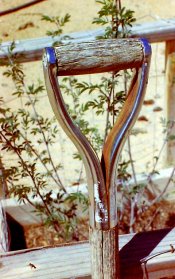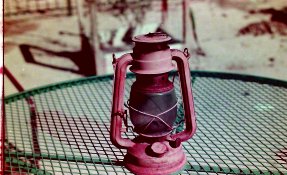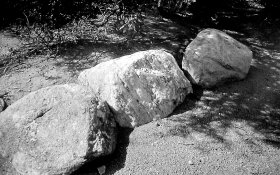The images from the link are of poor quality.
It was the first result from Google.
https://www.flickr.com/groups/1227372@N20/discuss/72157645680100403/
The images have so many impurities that as is looks like an intermediate with backing layer of graphite.
Mister with Kodak Eastman 35mm Color Intermediate Film SO-420 has not taken into account the advice
of colleagues who told him to expose the intermediate at tungsten light.
Not having the correct color temperature, the photographic results are not very useful for parameters of exposure.
In connection with intermediate Exposure Indexes, as well as all sensitive materials from film processing
laboratories in no technical data will find an ISO (positive b&w, color positive, negative sound, high contrast, ...).
I admit to me in private conversations word escape one ISO materials above.
Intermediate film is exposed to tungsten light at a value of 6 (not 1.6) and developed in ECN 2 process.
This is told by several people on that link .
Sure intermediate film has a reduced sensitivity .
Intermediet films were manufactured with either a backing layer of uncoated backing layer of graphite - Fuji and Kodak.
There were more much color positive films that were backing layer of graphite (Kodak, Agfa, Azo).
There was color positive film without backing layer of graphite - ORWO PC 7.
Most efficient antihalo layer is with graphite is sure it retains all the light.
Intermediate film is a material made specifically for film processing laboratories and was and is very expensive.
The cost of intermediate film in 1997 is ~ the double the price of the color negative.
Now I'm afraid to look at the catalog Kodak, for color negative the price has doubled in the last 2 years
(no longer have discount for students).
Considering that for movie uses about 4 to 10 times more color negative film than the usable length of the film.
Intermediate film is uses twice the usable length of the film.
The positive color is used up to several hundred (thousand) times the usable length of the film, print run of film.
The positive color films Kodak, Agfa and in 1983 came Azocolor (Romania) had antihalou layer with graphite.
ORWO Color Print Film PC 7 have not antihalou graphite layer.
I first read about the intention to remove the dorsal layer of graphite by ~ 1990.
Removing the layer of graphite, I read in a Agfa brochure that is the ecological reason.
~ 1994 Agfa released the positive color film CP 10 without graphite backing layer.
With no backing layer of graphite could work without prebath.
Removing the backing layer with graphite from the color positive films is logic, because the problems
that can occur at the color positive film are much lower than color negative film or intermediate film.
The latter two are more expensive (produced in quantities far lower than the positive color film).
The intermediate film is intended for making color master positive and color duplicate negative from color master positive.
There was reversible intermediate film which run directly after negative internegative ( duplicate negative).
The films CRI (Color reversal intermediate) uses VNF process (reversible color).
Lately digital transfer in the film took a large scale, intermediate films were made special for digital.
http://motion.kodak.com/motion/Products/Lab_And_Post_Production/Intermediate_Films/index.htm
Intermediate film can use by contact printing or optical printing.
Using optical printing will grow a little the contrast in the final image.
If to the color positive film the dorsal graphite antihalo was abandoned , intermediate film are made with and without
the backing layer graphite, it can be assumed that color negative and some test were made to eliminate the graphite backing layer.
I remember that color negative uncoated with graphite antihalo a in the bleaching stage shown in green opaque on suport.
Excuse my English.
George
 https://drive.google.com/open?id=0ByP8kkW_h00uRnMtTzFnT3R6NVk
https://drive.google.com/open?id=0ByP8kkW_h00uRnMtTzFnT3R6NVk https://drive.google.com/open?id=0ByP8kkW_h00uRnMtTzFnT3R6NVk
https://drive.google.com/open?id=0ByP8kkW_h00uRnMtTzFnT3R6NVk













